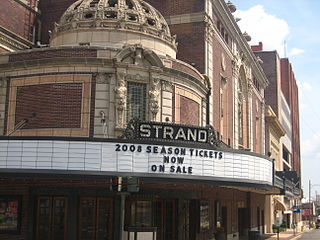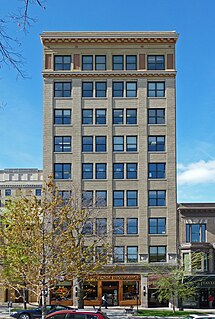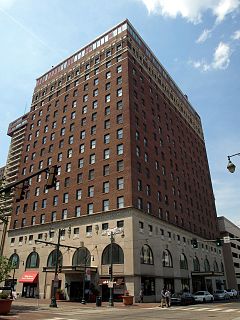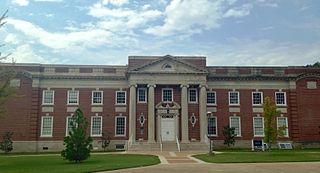Related Research Articles
Purcell & Elmslie (P&E) was the most widely know iteration of a progressive American architectural practice. P&E was the second most commissioned firm of the Prairie School, after Frank Lloyd Wright. The firm in all iterations was active from 1907 to 1921, with their most famous work being done between 1913 and 1921.
Thomas Wilson Williamson was a Kansas architect who specialized in designing school buildings in Kansas, Iowa, and Missouri.

Reuben Harrison Hunt, also known as R. H. Hunt, was an American architect who spent most of his life in Chattanooga, Tennessee. He is considered to have been one of the city's most significant early architects. He also designed major public building projects in other states. He was a principal of the R.H. Hunt and Co. firm.
Henry O. Jaastad (1872–1965) was an influential Tucson, Arizona architect. His firm created over 500 buildings and Jaastad was Mayor of Tucson for 14 years. A number of his works are listed on the U.S. National Register of Historic Places for their architecture.

August Geiger was one of the most prominent American architects in South Florida from 1905 to the late 1940s. He experimented in Mission, Neo-Renaissance and Art Deco architecture, but is most noted for his works in the Mediterranean Revival style. A number of his works are listed on the U.S. National Register of Historic Places.

Morris Homans Whitehouse was an American architect whose work included the design of the Gus Solomon United States Courthouse in Portland, Oregon.

Barnett, Haynes & Barnett was a prominent architectural firm based in St. Louis, Missouri. Their credits include many familiar St. Louis landmarks, especially a number related to the local Catholic church. Their best-known building is probably the Cathedral Basilica of St. Louis. A number of the firm's works are listed on the U.S. National Register of Historic Places.

The Shrine Building in downtown Memphis, Tennessee was built in 1923 to serve as the headquarters of the Al Chymia Shrine, a group of Shriners. It was listed on the National Register of Historic Places in 1979. It was converted to apartments in 1981 and was converted again in 2005 to house 75 condominium apartments.

Sanguinet & Staats was an architectural firm based in Fort Worth, Texas, with as many as five branch offices in Texas. The firm specialized in steel-frame construction and built many skyscrapers in Texas. The firm also accepted commissions for residential buildings, and designed many buildings listed on the National Register of Historic Places.

James B. Cook was an English-trained architect who worked in Memphis, Tennessee in the 1800s.

Edward Fairfax Neild Sr., was an American architect originally from Shreveport, Louisiana. He designed the Harry S. Truman Presidential Library and Museum in Independence, Missouri. He was selected for the task by U.S. President Harry Truman.

McKissack & McKissack is an American architecture, engineering, program management and construction firm based in Washington, D.C. It is the oldest minority-owned architecture and construction company in the United States.

Emile Weil was a noted architect of New Orleans, Louisiana.
Hanker & Cairns was an architectural firm of Memphis, Tennessee. It was formed in 1903 as a partnership of William Julius Hanker and Baynard S. Cairns.

Law, Law & Potter was an architect firm in Madison, Wisconsin; Potter Lawson, Inc. is its modern-day successor. Some of its buildings are listed on the U.S. National Register of Historic Places for their architecture. The firm was Madison's largest and "arguably most important" architectural firm in the 1920s and 1930s.

Hotel Claridge is a historic hotel building in Memphis, Tennessee, U.S.. It was built in 1924 for Charles Levy and Morris Corn, two businessmen from St. Louis, Missouri. Its construction cost $1.5 million, and it was designed by the Memphis architectural firm of Jones & Furbringer and the St. Louis firm of Barnett, Haynes & Barnett.
Hubert Thomas McGee, commonly known as Hubert T. McGee, was an American architect based in Memphis, Tennessee. A number of his works are listed on the National Register of Historic Places. He had no formal architectural education but studied with architect Reuben A. Heavner of Jackson, Tennessee.

George Mahan Jr. was an American architect based in Memphis, Tennessee. He designed courthouses, many residences, and schools. Many of his designs were Neoclassical architecture style, and several buildings he designed are listed on the National Register of Historic Places (NRHP).
Nisbet & Paradice was an architectural firm in Idaho. It was a partnership of architects Benjamin Morgan Nisbet and Frank H. Paradice, Jr. formed in 1909. The partnership lasted five years. They dissolved it in 1915, and Nisbet moved to Twin Falls, Idaho to establish an individual practice, and Paradice did likewise in Pocatello, Idaho. A number of their works are recognized by listings on the National Register of Historic Places (NRHP).

Walk Claridge Jones Sr. was an American architect based in Memphis, Tennessee. He designed buildings listed on the National Register of Historic Places like the First Congregational Church and Parish House and the Pauline Cheek Barton House. He co-founded Jones & Furbringer with Max H. Furbringer, and they designed many more buildings, including the NRHP-listed Hotel Claridge.
References
- ↑ Langmead, Donald (2009). Icons of American Architecture: From the Alamo to the World Trade Center. Westport, Connecticut: Greenwood Press. p. 159. ISBN 9780313342097. OCLC 855778366.
- 1 2 "History, brg3s architects".
- 1 2 3 4 5 6 7 8 9 "National Register Information System". National Register of Historic Places . National Park Service. July 9, 2010.